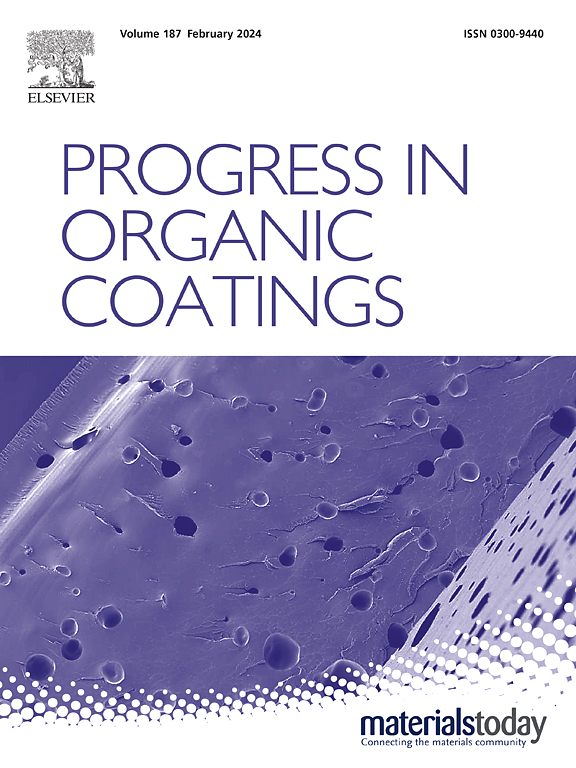Durable icephobic acrylic polyurethane coating with ultra-low interfacial toughness for efficient large-scale deicing
IF 6.5
2区 材料科学
Q1 CHEMISTRY, APPLIED
引用次数: 0
Abstract
Ice accretion adversely affects various productions and daily activities. Existing passive deicing materials are divided into icephobic and low interfacial toughness (LIT) coatings, suitable for ice removal of small- and large-area, respectively. However, they tend to lack scalability or durability, limiting the practical utility. Herein, thermosetting acrylic polyurethane (APU) was investigated for large-scale deicing applications by examining the detachment behavior of extended-length ice on its surface. Despite the ice adhesion strength reaching up to 400 kPa, the APU demonstrated interfacial toughness with ice as low as 0.88 J/m2, with the apparent ice adhesion strength below 48 kPa for ice measuring 20 cm in length. Further, by modifying the surface of APU with liquid-like polydimethylsiloxane chains, we realized the combination of LIT coating and liquid-like surface for the first time. The interface between this resultant double-layered coating and ice achieved both low toughness (<1 J/m2) and low strength (<100 kPa) (LTS), enabling efficient ice removal at any accumulation scale. This LTS coating also maintained excellent ice resistance after multiple icing/deicing cycles, sandpaper abrasion, and water flow impact. When applied to various substrates, it still exhibited superior ice resistance, demonstrating strong potential for broad deicing applications.
耐用的憎冰丙烯酸聚氨酯涂层,具有超低的界面韧性,适用于高效的大规模除冰
冰的增加对各种生产和日常活动产生不利影响。现有的被动除冰材料分为疏冰涂层和低界面韧性涂层,分别适用于小面积除冰和大面积除冰。然而,它们往往缺乏可伸缩性或持久性,从而限制了实际用途。本文研究了热固性丙烯酸聚氨酯(APU)在大规模除冰中的应用,考察了其表面长冰的脱离行为。尽管冰的黏附强度高达400 kPa,但APU与冰的界面韧性低至0.88 J/m2,当冰长度为20 cm时,APU的表观黏附强度低于48 kPa。此外,通过用液态聚二甲基硅氧烷链修饰APU表面,首次实现了LIT涂层与液态表面的结合。由此产生的双层涂层和冰之间的界面具有低韧性(1 J/m2)和低强度(100 kPa) (LTS),可以在任何堆积规模下有效除冰。这种LTS涂层在多次结冰/除冰循环、砂纸磨损和水流冲击后也保持了优异的耐冰性。当应用于各种基材时,它仍然表现出优异的抗冰性,显示出广泛除冰应用的强大潜力。
本文章由计算机程序翻译,如有差异,请以英文原文为准。
求助全文
约1分钟内获得全文
求助全文
来源期刊

Progress in Organic Coatings
工程技术-材料科学:膜
CiteScore
11.40
自引率
15.20%
发文量
577
审稿时长
48 days
期刊介绍:
The aim of this international journal is to analyse and publicise the progress and current state of knowledge in the field of organic coatings and related materials. The Editors and the Editorial Board members will solicit both review and research papers from academic and industrial scientists who are actively engaged in research and development or, in the case of review papers, have extensive experience in the subject to be reviewed. Unsolicited manuscripts will be accepted if they meet the journal''s requirements. The journal publishes papers dealing with such subjects as:
• Chemical, physical and technological properties of organic coatings and related materials
• Problems and methods of preparation, manufacture and application of these materials
• Performance, testing and analysis.
 求助内容:
求助内容: 应助结果提醒方式:
应助结果提醒方式:


